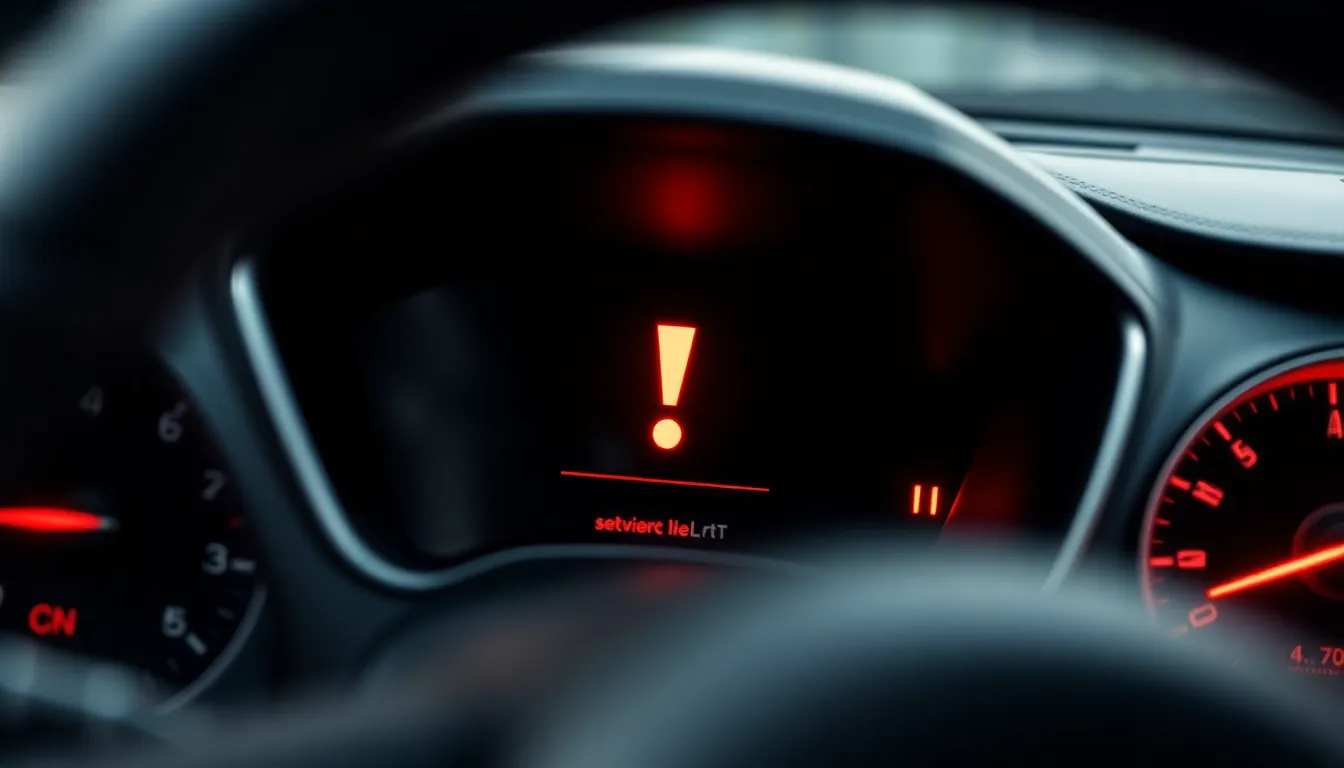Seeing a red exclamation mark on the dashboard can send a jolt of panic through any driver. This warning light isn’t just a simple notification; it signals that something needs immediate attention. Ignoring it could lead to serious issues down the road, both figuratively and literally.
Understanding what this symbol means is crucial for maintaining vehicle safety and performance. It often relates to critical systems like the brakes, oil pressure, or tire pressure. By recognizing the implications of that red exclamation mark, drivers can take proactive steps to address potential problems before they escalate.
Table of Contents
ToggleUnderstanding The Red Exclamation Mark On Dashboard
The red exclamation mark on a vehicle’s dashboard signals urgent attention to critical systems. Recognizing its meaning helps maintain both safety and performance.
Common Causes
- Brake System Issues: A malfunction in the braking system, such as low brake fluid levels or worn brake pads, triggers the warning light.
- Oil Pressure Problems: Insufficient oil pressure, often due to low oil levels or oil pump failure, causes the red exclamation mark to illuminate.
- Tire Pressure Alerts: Abnormal tire pressure, either too low or too high, can activate the warning light, indicating the need for correction.
- Electronic Stability Control: Malfunctions in electronic stability control systems may also cause this warning, requiring immediate assessment.
- Battery or Charging Issues: A failing battery or charging system could lead to voltage drops, prompting the warning light to appear.
General Implications
The red exclamation mark signifies critical issues that could compromise vehicle safety. Addressing these warnings promptly can prevent further damage and costly repairs. Ignoring this alert can lead to serious accidents or breakdowns, emphasizing the need for immediate investigation and resolution. Regular maintenance checks reduce the likelihood of these problems, ensuring a safer driving experience.
Importance Of Addressing The Warning

Addressing the red exclamation mark warning light on a vehicle’s dashboard is essential for ensuring safety and optimal vehicle performance. Ignoring this warning can result in severe consequences.
Safety Concerns
Safety concerns arise when the red exclamation mark indicates critical system failures. Failing brakes or low oil pressure can lead to loss of control, resulting in accidents. Promptly addressing the warning light minimizes risks, protects occupants, and enhances road safety. Drivers should immediately assess the vehicle’s condition, as neglecting these issues may cause significant harm to themselves and others on the road.
Vehicle Performance
Vehicle performance deteriorates with unresolved issues linked to the red exclamation mark. Problems such as inadequate oil pressure and malfunctioning brakes can cause engine strain and reduced efficiency. Addressing these warnings ensures the vehicle operates smoothly, maintains fuel efficiency, and prolongs the lifespan of essential components. Timely attention to the warning light ultimately contributes to a better driving experience and lower repair costs.
Steps To Take When You See The Warning
Seeing a red exclamation mark on the dashboard commands immediate action. Addressing the underlying issues promptly ensures vehicle safety and optimal performance.
Immediate Actions
- Pull Over Safely: Stop the vehicle in a safe location to assess the situation.
- Turn Off the Engine: Shut off the engine to prevent further damage while assessing issues.
- Check for Obvious Problems: Inspect the vehicle for any visible leaks, flat tires, or smoke. Look for signs of brake or tire trouble.
- Assess Warning Light Meaning: Identify the specific system affected by the warning light. This indicates what the likely problem could be.
- Call for Roadside Assistance: If issues appear serious or unknown, contact a roadside assistance service for support or towing.
Consulting The Owner’s Manual
- Locate the Manual: Access the vehicle’s owner’s manual, either in print or digital format.
- Find Warning Light Information: Search for a section on dashboard warning lights for specific descriptions and meanings.
- Follow Recommended Actions: Adhere to the manual’s guidance regarding troubleshooting steps or necessary actions to take.
- Contact a Professional: If problems persist or solutions in the manual aren’t effective, consult a certified mechanic for expert assistance.
Taking these steps ensures safety and aids in maintaining the vehicle’s performance.
Preventative Measures
Taking proactive steps can help prevent the appearance of the red exclamation mark on the dashboard. Adhering to a regular maintenance schedule and staying vigilant about dashboard indicators can significantly enhance vehicle safety and performance.
Regular Maintenance
Regular maintenance ensures optimal vehicle functionality and longevity. Following a service schedule that includes oil changes every 3,000 to 5,000 miles, brake inspections, and tire rotations helps identify potential issues early. Fluid checks, including brake fluid, coolant, and transmission fluid, are also critical. Mechanics often provide recommendations based on specific vehicle makes and models, ensuring comprehensive care tailored to unique needs.
Monitoring Dashboard Indicators
Monitoring dashboard indicators regularly helps catch potential issues before they escalate. Familiarizing with dashboard lights enables quicker responses to warnings. Understanding each warning’s significance, including the red exclamation mark, facilitates timely action. Regularly checking the dashboard informs drivers of current vehicle status and alerts them to any alarming changes, promoting safer driving habits.
The presence of a red exclamation mark on the dashboard is a serious signal that demands immediate attention. By recognizing its significance and responding promptly, drivers can safeguard their safety and enhance their vehicle’s performance. Taking proactive measures such as regular maintenance checks and understanding warning lights can prevent minor issues from escalating into major problems. Addressing concerns as they arise not only ensures a smoother driving experience but also helps avoid costly repairs down the road. Ultimately, staying informed and vigilant is key to maintaining vehicle health and safety on the road.



